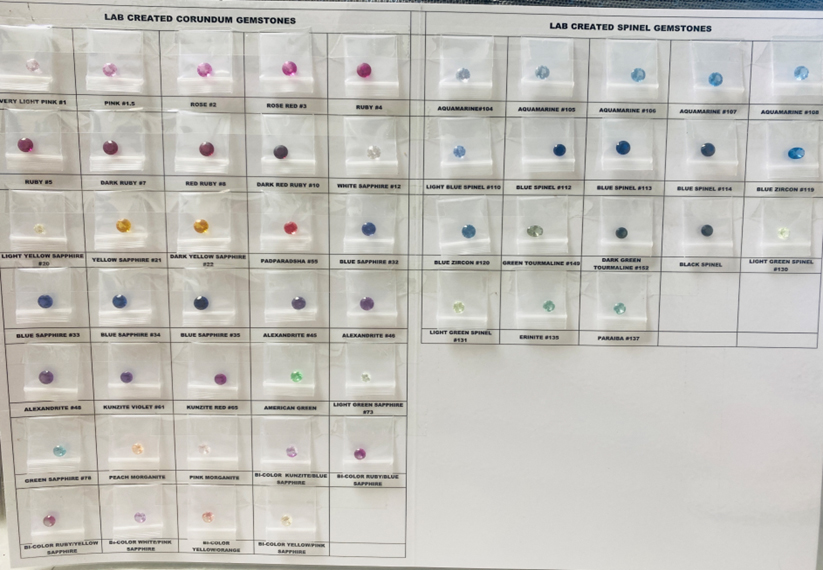Corundum gemstones have captivated the hearts of gem enthusiasts for centuries, renowned for their stunning beauty and remarkable durability. Among the various corundum gemstones, synthetic corundum has emerged as a fascinating innovation in the world of gemology. In this article, we will explore the allure of corundum gemstones, with a specific focus on synthetic corundum. We will delve into the history, characteristics, production methods, and contemporary uses of these mesmerizing gems.
The Rich History Of Corundum Gemstones
Corundum, a crystalline form of aluminum oxide, has a storied history that dates back thousands of years. The name “corundum” is derived from the Tamil word “kurundam,” which means “ruby” or “sapphire.” Historically, corundum was often confused with other gemstones like spinel, until advances in mineralogy and gemology allowed for accurate classification.
Natural corundum gemstones, encompassing rubies and sapphires, have held profound cultural significance in various civilizations. Rubies, in particular, were considered the “king of gemstones” in ancient India and were associated with protection, power, and passion. Meanwhile, sapphires were linked to wisdom and nobility.
The Rise Of Synthetic Corundum
The quest to replicate the beauty and durability of natural corundum led to the development of synthetic corundum in the late 19th century. This marked a significant turning point in the world of gemology and jewelry making. Synthetic corundum, also known as lab-grown or man-made corundum, shares the same chemical composition and crystal structure as its natural counterpart.
The primary motivation behind the creation of synthetic corundum was to provide an ethical and sustainable alternative to mined gemstones. As the demand for corundum grew, so did concerns about the environmental and ethical impact of mining. Synthetic corundum offered a solution by reducing the need for mining while ensuring high-quality gemstones.
Characteristics Of Synthetic Corundum
Synthetic corundum possesses several key characteristics that make it a desirable choice for both jewelry enthusiasts and gemstone professionals:
- Consistency: Unlike natural corundum, synthetic corundum exhibits consistent color and clarity, making it easier to match stones for jewelry pieces.
- Durability: Synthetic corundum is exceptionally durable, ranking just below diamond on the Mohs scale of hardness, making it ideal for everyday wear.
- Cost-effectiveness: Synthetic corundum is often more affordable than its natural counterparts, making it an accessible option for a wide range of consumers.
- Clarity enhancements: Some synthetic corundum may undergo treatments to improve their clarity, enhancing their overall appearance.
Production Methods Of Synthetic Corundum
Synthetic corundum is created using various methods, each with its own advantages and applications. The most common methods include:
- Flame Fusion: This method involves melting aluminum oxide and allowing it to crystallize on a seed crystal. Flame fusion is known for producing high-quality synthetic corundum with excellent color and clarity.
- Hydrothermal Growth: In this method, synthetic corundum is grown from a solution at high temperatures and pressures. Hydrothermal growth is often used to produce synthetic sapphires for various industrial applications.
- Verneuil Process: Named after its inventor, Auguste Verneuil, this process involves melting aluminum oxide and allowing it to solidify as it is drawn up a rotating boule. The Verneuil process is commonly used to create synthetic ruby and sapphire.
Contemporary Uses Of Synthetic Corundum
The applications of synthetic corundum extend far beyond jewelry, owing to its remarkable properties. Here are some contemporary uses of synthetic corundum:
- Jewelry: Synthetic corundum is widely used in jewelry, offering a more affordable alternative to natural corundum while maintaining exceptional beauty and durability. It is often used in rings, earrings, pendants, and more.
- Watchmaking: Synthetic sapphire crystals are used in high-end watches due to their scratch-resistant and transparent nature. They protect the watch face while allowing for a clear view of the dial.
- Laser Technology: Synthetic corundum is used as laser rods and optical components due to its ability to transmit infrared light.
- Abrasive Applications: Synthetic corundum is used as an abrasive material in various industries, including metalworking, electronics manufacturing, and dentistry.
- Scientific Research: Synthetic corundum is used in scientific instruments and experiments due to its high resistance to chemicals and extreme temperatures.
The Ethical And Environmental Advantages
One of the most compelling aspects of synthetic corundum is its ethical and environmental advantages. Here’s how it contributes to a more sustainable and responsible gemstone industry:
- Reduced Environmental Impact: Synthetic corundum reduces the need for gemstone mining, which can be environmentally destructive. This mitigates habitat disruption, soil erosion, and water pollution associated with mining operations.
- Elimination of Unethical Practices: Synthetic corundum eliminates the risk of purchasing gemstones that have been sourced through unethical means, such as conflict or child labor.
- Transparency: The production of synthetic corundum is a controlled process, which means that its origin and history are known, ensuring transparency and ethical accountability.
- Conservation of Natural Resources: By choosing synthetic corundum, consumers contribute to the conservation of natural resources, as no natural corundum deposits are depleted in the process.
Caring For Synthetic Corundum Gemstones
Caring for synthetic corundum gemstones is relatively straightforward. Here are some tips to keep them looking their best:
- Cleaning: Clean synthetic corundum jewelry with a mild soap and warm water solution. Use a soft brush to gently scrub away dirt and grime. Rinse thoroughly and pat dry with a soft cloth.
- Avoid Harsh Chemicals: Avoid exposing synthetic corundum to harsh chemicals, as they can damage the gemstone. Remove jewelry when using cleaning agents or engaging in activities that involve chemicals.
- Storage: Store synthetic corundum jewelry in a separate compartment or pouch to prevent scratches. It’s also advisable to keep jewelry away from direct sunlight to avoid color fading.
- Regular Inspections: Periodically inspect your synthetic corundum jewelry for loose settings or damage. Promptly address any issues to prevent further damage.
Conclusion: The Timeless Appeal Of Synthetic Corundum
Synthetic corundum has emerged as a remarkable and sustainable alternative to its natural counterparts, offering beauty, durability, and ethical peace of mind. While natural corundum gemstones continue to be cherished for their unique history and characteristics, synthetic corundum has found its own place in the world of gemology and jewelry design.
As technology continues to advance, the production of synthetic corundum is likely to become even more refined, expanding its applications and accessibility. Whether you’re drawn to the ethical advantages, the cost-effectiveness, or the stunning aesthetics, synthetic corundum stands as a shining example of how innovation can enhance the beauty of nature without compromising on sustainability or ethics. With synthetic corundum, the allure of corundum gemstones continues to evolve, making them a captivating choice for gemstone enthusiasts worldwide.














